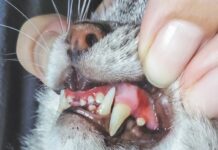Feline oral squamous cell carcinoma (FOSCC) accounts for about 10% of all feline tumors and is the most common cancer of the mouth in cats. While slow to metastasize, it is aggressive locally and has a grave prognosis even with surgery and/or radiation therapy. Three months is the average survival time after diagnosis.
Dr. Erin Dickerson and her team at the University of Minnesota looked at a drug that disrupts the mechanisms that feed cancer cells. Since cancer cells are rapidly growing, they have a high nutrient requirement.
Using a drug currently for humans with head and neck cancers, the goal was to interfere with lactic acid transport between tumor cells and fibroblasts, essentially trying to “starve out” the cancer cells. The drug shows promise for cats.
Two other studies are using light therapy to fight these cancers. Light or photodynamic therapy has two components. One is the light itself. The second is to use a light sensitive chemical that reacts with oxygen when exposed to the special light. The oxidative reaction is toxic to cancer cells.
Utrecht University researcher Dr. Sabrina Santos Oliveira is using nanotechnology to get the reactive chemical more precisely to the targeted cancer cells. Dr. Michelle Oblak, from the University of Guelph, uses a different type of nanoparticle to do the same precision targeting of the cancer cells. Both methods reduce the damage to surrounding healthy tissues. More work needs to be done, but this work is encouraging.




